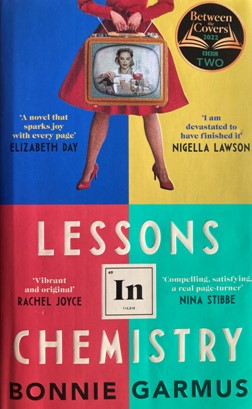Dry Drayton Book Group choice February 2024

Lessons in Chemistry by Bonnie Garmus is her debut novel which tells the story of the chemist Elizabeth Zott. Set in the early 1960s Elizabeth works as a research chemist and her all-male team take a very unscientific view of equality. The exception is Calvin Evans who falls in love with her but the relationship does not last due to Calvin’s untimely death. Elizabeth then finds herself unsupported by management and her colleagues at the research laboratories and when she finds that she is pregnant with Calvin’s child, she is sacked from her job. Being a resourceful character, Elizabeth manages to continue to give (paid) advice to researchers from the laboratories so that they are able to understand their results of the research but this becomes increasingly problematic as her daughter, Madeline grows. She is supported by her neighbour, Harriet, who is herself in an unhappy marriage with a boorish husband. Harriet provides a lot of childcare for Madeline while Elizabeth is at work or out training relishing the opportunity to get out of the house and providing a feminist cause to support In a chance conversation with Walter Pine who happens to be a TV producer and another single parent of a daughter in Madeline’s class, Elizabeth finds herself in the pilot programme of Supper at Six, a cookery programme aimed at teaching women to cook. However Elizabeth takes charge of the situation and delivers the programme on her terms where she does more than just teach women to cook, encouraging them to achieve their career dreams.
This is an amusing and easy read which in general the group enjoyed. The group agreed that the story tackles a number of important issues head-on including misogyny, discrimination and sexual abuse all of which were sadly commonplace in the 1950s and 1960s when the story is set. The themes are well articulated and the characters are well described. However. the group thought that the themes and characters were exaggerated and, for some, too many stereotypes were included. Nonetheless this all inevitably helped to give character to the plot. The treatment of the dog “Six-thirty” which is portrayed as an anthropomorphic character divided the group. For some it added to the story and provided further humorous incidents, for others it was completely unbelievable and a distraction. The depiction of the scientific nature of cookery was thought completely believable and added to the humour of the story. For some the ending of the story came too swiftly and was contrived but it did help to bring the lives of the characters to a satisfactory conclusion.
Given these challenging themes, the group had an interesting discussion about their own experiences and the extent to which they are still prevalent in the workplace today. The way in which the story depicts the supplementary characters was interesting and showed how the attitudes of the day are reinforced by some of the women characters. Whilst some are strongly supportive of Elizabeth’s efforts particularly Elizabeth’s neighbour Harriet, others such as Madeline’s teacher and Miss Frask are unwilling to support Elizabeth’s unorthodox approach to life.
Leave a comment